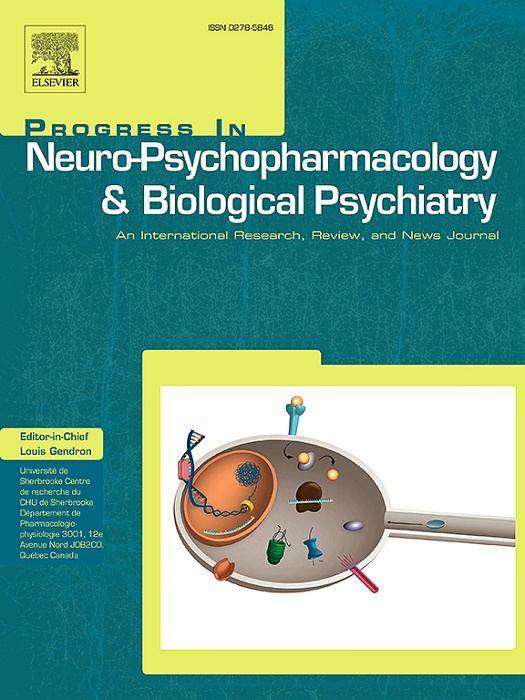睡眠-情绪联系:性情调节神经炎症、生物钟基因和大鼠多巴胺能受体的表达。
IF 3.9
2区 医学
Q1 CLINICAL NEUROLOGY
Progress in Neuro-Psychopharmacology & Biological Psychiatry
Pub Date : 2025-07-10
DOI:10.1016/j.pnpbp.2025.111443
引用次数: 0
摘要
气质在个体对情绪障碍的易感性中起着关键作用,特别是在睡眠中断的情况下,其机制仍未得到充分探索。本研究考察了矛盾睡眠剥夺(PSD)如何影响高探索性和低探索性(HE和LE) Wistar大鼠的行为和神经生物学结果,这些大鼠代表了不同的气质特征。从80只青春期左右的雄性大鼠中,选取20只HE大鼠和20只LE大鼠,采用开放式试验,随机分配到PSD或对照组。行为测试评估冲动、冒险、焦虑样行为、快感缺乏、绝望样行为和记忆表现。生物学终点包括血尿酸、血浆细胞因子、海马氧化应激(谷胱甘肽和脂质过氧化)、细胞因子(白介素[IL] 1β、IL-6、IL-4)、昼夜节律调节因子(Clock、Bmal1、Per和Cry基因)的基因表达、血清素能和犬尿氨酸途径酶(色氨酸羟化酶2、Tph2;色氨酸2 3-Dioxygenase Tdo2;吲哚胺2,3-双加氧酶(Ido1)、多巴胺D1 (Drd1)和D2受体(Drd2)蛋白水平(Western Blotting测定)。PSD加重了HE大鼠的冒险行为,增加了LE大鼠的快感缺乏和不动。两组患者均出现PSD后的记忆损伤。在分子水平上,暴露于PSD的HE大鼠表现为脂质过氧化、炎症、昼夜节律基因和Tph2上调以及Drd1表达升高。LE大鼠表现出血清素能基因表达降低,犬尿氨酸途径激活增加,选择性Drd2上调。这些发现表明,气质塑造了对快速眼动睡眠缺失的行为和神经生物学脆弱性,具有与躁狂和抑郁样表型相关的独特特征。这支持了在理解情绪障碍病理生理学和指导个性化治疗策略的气质知情框架的相关性。本文章由计算机程序翻译,如有差异,请以英文原文为准。
The sleep-mood connection: Temperament modulates neuroinflammation, clock genes, and dopaminergic receptors expression in rats
Temperament plays a critical role in individual susceptibility to mood disorders, particularly in contexts of sleep disruption, through still underexplored mechanisms. This study examined how paradoxical sleep deprivation (PSD) affects behavioral and neurobiological outcomes in high- and low-exploratory (HE and LE) Wistar rats, representing distinct temperament profiles. From a cohort of 80 periadolescent males, 20 HE and 20 LE rats were identified using an open-field test and randomly assigned to PSD or control conditions. Behavioral testing evaluated impulsivity, risk-taking, anxiety-like behavior, anhedonia, despair-like behavior, and memory performance. Biological endpoints included blood uric acid, plasma cytokines, and hippocampal oxidative stress (glutathione and lipid peroxidation), cytokines (interleukin [IL] 1β, IL-6, IL-4), gene expression of circadian regulators (Clock, Bmal1, Per and Cry genes), serotonergic and kynurenine pathway enzymes (Tryptophan Hydroxylase 2, Tph2; Tryptophan 2,3-Dioxygenase,Tdo2; Indoleamine 2,3-Dioxygenase,Ido1), and dopamine D1 (Drd1) and D2 receptor (Drd2) protein levels (measured by Western Blotting). PSD exacerbated risk-taking in HE rats and increased anhedonia and immobility in LE rats. Memory impairments were observed in both groups following PSD. At molecular level, HE rats exposed to PSD showed increased lipid peroxidation, inflammation, upregulation of circadian genes and Tph2, and elevated Drd1 expression. LE rats displayed reduced serotonergic gene expression, increased kynurenine pathway activation, and selective Drd2 upregulation. These findings indicate that temperament shapes behavioral and neurobiological vulnerability to rapid eye movement sleep loss, with distinct profiles associated with mania- and depression-like phenotypes. This supports the relevance of temperament-informed frameworks in understanding mood disorder pathophysiology and guiding personalized treatment strategies.
求助全文
通过发布文献求助,成功后即可免费获取论文全文。
去求助
来源期刊
CiteScore
12.00
自引率
1.80%
发文量
153
审稿时长
56 days
期刊介绍:
Progress in Neuro-Psychopharmacology & Biological Psychiatry is an international and multidisciplinary journal which aims to ensure the rapid publication of authoritative reviews and research papers dealing with experimental and clinical aspects of neuro-psychopharmacology and biological psychiatry. Issues of the journal are regularly devoted wholly in or in part to a topical subject.
Progress in Neuro-Psychopharmacology & Biological Psychiatry does not publish work on the actions of biological extracts unless the pharmacological active molecular substrate and/or specific receptor binding properties of the extract compounds are elucidated.

 求助内容:
求助内容: 应助结果提醒方式:
应助结果提醒方式:


